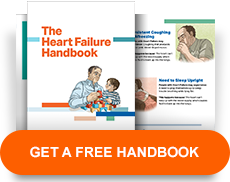ACE inhibitor
A medicine that helps lower blood pressure and helps in treating congestive Heart Failure by blocking production of angiotensin II, a hormone that circulates in the blood and squeezes blood vessels.
ARB
Another medicine that helps block the action of angiotensin II, a hormone that can cause high blood pressure and increase the workload on the heart.
Atrium
One of the heart’s top two chambers. Blood arriving back in the atria (plural of “atrium”) gets pushed down into the ventricles after circulating through the body and giving up its oxygen to supply the organs.
Blood pressure
The force with which blood pushes against the walls of the arteries as the heart pumps.
Diastolic
The lowest pressure in the arteries as the heart muscle relaxes, allowing it to fill with blood. In blood pressure readings it appears as the second of the two numbers.
Diuretics (water pills)
Drugs that increase urine production to help lower the amount of sodium and water in the blood. This in turn helps fight fluid buildup and lower blood pressure.
Edema (also known as fluid or water retention)
Swelling, usually of the legs, hands, and feet, when too much fluid builds up in the body tissues. It can be a signal of heart and circulation problems.
Ejection fraction (EF)
A measure of how well the heart is pumping out blood, used to diagnose and monitor Heart Failure. The ejection fraction for a normal heart ranges between 50 and 70.
High blood pressure
A disease where the blood flows too forcefully through the arteries. In time, this can stretch the artery walls beyond what’s healthy, which can damage the arteries.
Preserved ejection fraction (HFpEF)—or diastolic Heart Failure
The heart muscle contracts, or squeezes, normally, but the ventricles don’t relax properly, preventing them from filling completely. So the body fails to get all the blood it needs.
Reduced ejection fraction (HFrEF)—also known as systolic Heart Failure
The heart muscle does not contract, or squeeze, effectively or normally, so less oxygen-rich blood is pumped out to the body.
Sodium
A mineral that’s naturally present in some foods. Everyday table salt (sodium chloride) is 40% sodium by weight. Too much sodium can cause fluid retention and increase the workload on the heart.
Symptom
Something patients experience that can’t be measured—like trouble lying flat to sleep or getting tired/winded after walking up a flight of stairs. A sign—as in “signs and symptoms”—is something like blood pressure that can be measured by others.
Systolic
The blood pressure at the moment the heart beats, when the heart muscle contracts and there’s maximum pressure in the arteries as the blood flows through them. In blood pressure readings, it appears as the first of the two numbers.
Ventricle
A hollow space in a body organ. In the heart, this refers to one of the two lower chambers where the blood is pumped back out to the arteries.





